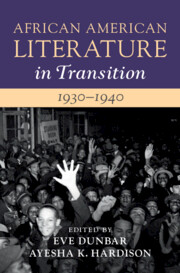Book contents
- African American Literature in Transition, 1930–1940
- African American Literature in Transition
- African American Literature in Transition, 1930–1940
- Copyright page
- Contents
- Figures
- Contributors
- Preface
- Chronology, 1930–1940
- Introduction
- Part I Productive Precarity and Literary Realism
- Part II New Deal, New Methodologies
- Chapter 4 Folklore, Folk Life, and Ethnography in African American Writing of the 1930s
- Chapter 5 New Deal Discourses
- Chapter 6 Black Theatre Archives and the Making of a Black Dramatic Tradition
- Part III Cultivating (New) Black Readers
- Part IV International, Black, and Radical Visions
- Index
- References
Chapter 6 - Black Theatre Archives and the Making of a Black Dramatic Tradition
from Part II - New Deal, New Methodologies
Published online by Cambridge University Press: 25 March 2022
- African American Literature in Transition, 1930–1940
- African American Literature in Transition
- African American Literature in Transition, 1930–1940
- Copyright page
- Contents
- Figures
- Contributors
- Preface
- Chronology, 1930–1940
- Introduction
- Part I Productive Precarity and Literary Realism
- Part II New Deal, New Methodologies
- Chapter 4 Folklore, Folk Life, and Ethnography in African American Writing of the 1930s
- Chapter 5 New Deal Discourses
- Chapter 6 Black Theatre Archives and the Making of a Black Dramatic Tradition
- Part III Cultivating (New) Black Readers
- Part IV International, Black, and Radical Visions
- Index
- References
Summary
This chapter examines how and why Black dramatists and dramas of the Federal Theatre Project (FTP) were forgotten and the role of the Black Arts Movement in recovering the repertoire of Black federal theatre. Only a fraction of the Black plays held in the FTP archives have been anthologized or staged since the 1930s. This chapter examines the broad range of Black dramas developed on the project and still waiting to be surfaced. It focuses in particular on two neglected Black folk dramas: Did Adam Sin? and Cinda, alongside Theodore Ward’s better known social protest drama Big White Fog. Black playwrights and Negro Units dramatized the Depression as it unfolded. The chapter also roots the Black family drama within a longer Black dramatic tradition. Rather than see August Wilson’s Pittsburgh Cycle plays as stretching back to a tradition beginning with Richard Wright’s collaboration with Paul Green on the stage play of Native Son (1941) or Lorraine Hansberry’s Raisin in the Sun (1959), sourcing contemporary Black drama to the Black federal theatre suggests that the staging of contemporary gender roles and race relations has a much longer and richer theatre history.
Keywords
- Type
- Chapter
- Information
- African American Literature in Transition, 1930–1940 , pp. 170 - 208Publisher: Cambridge University PressPrint publication year: 2022

